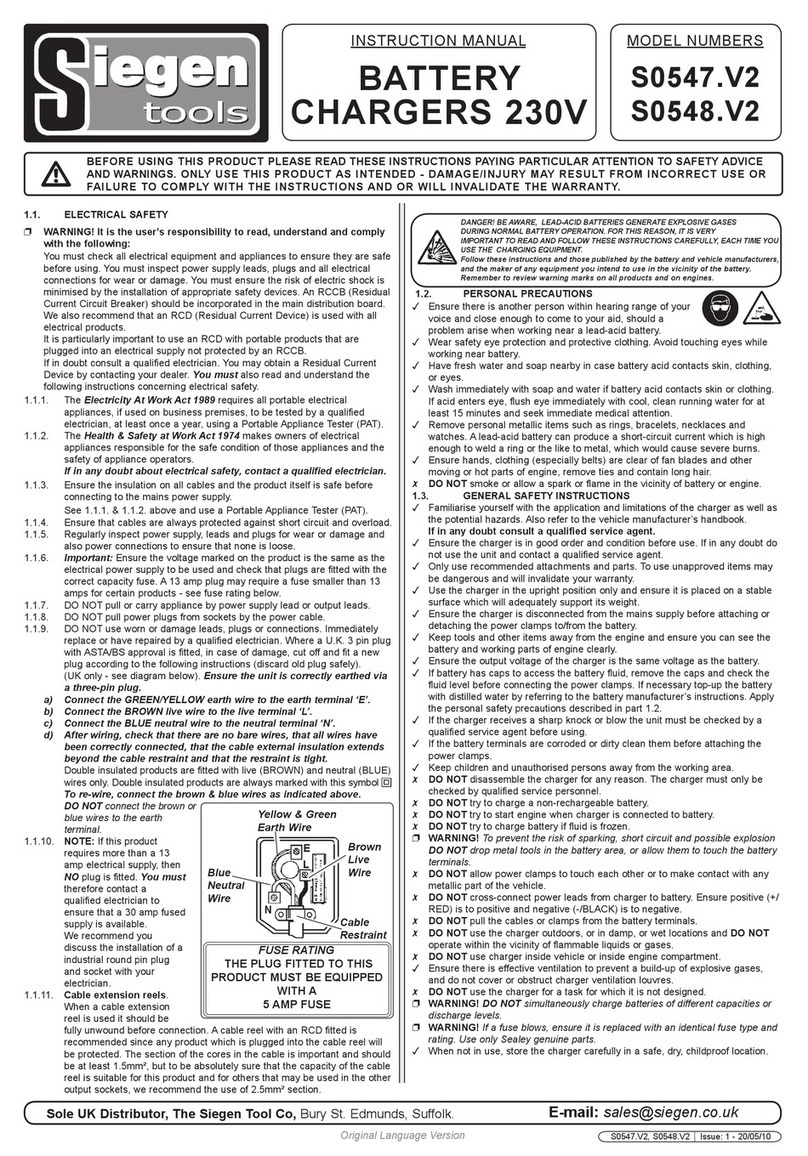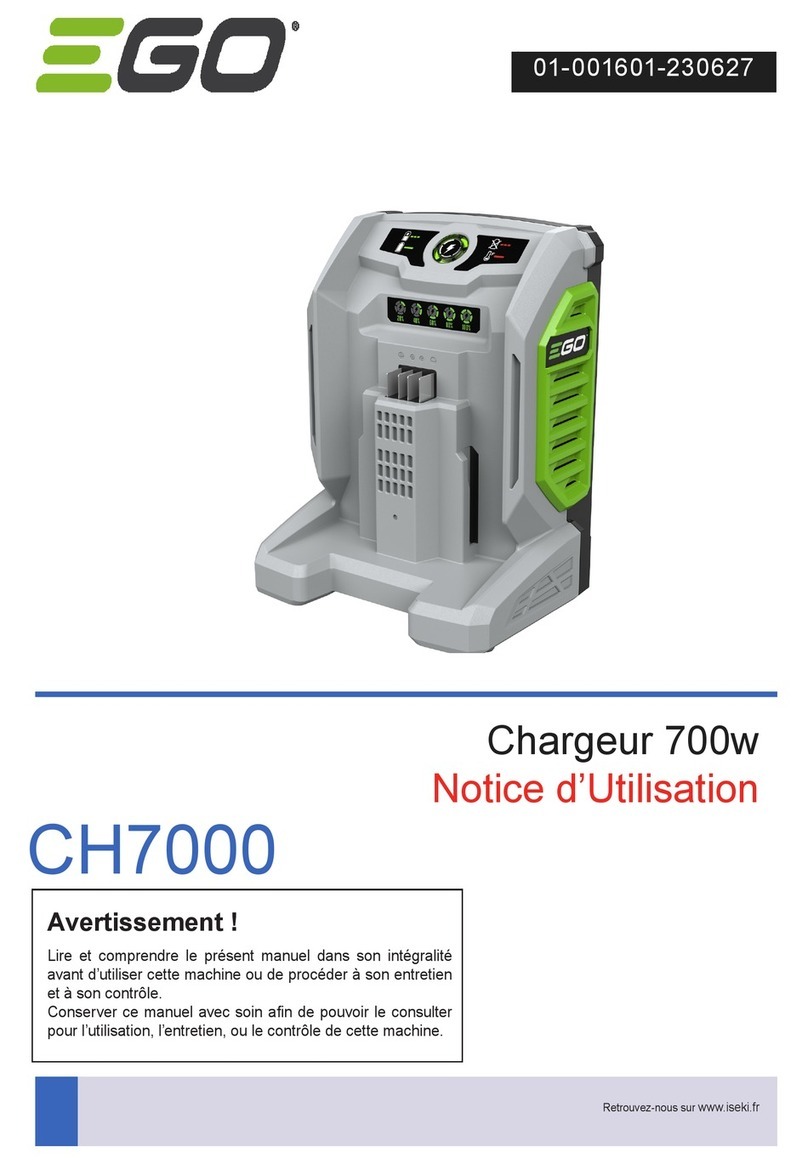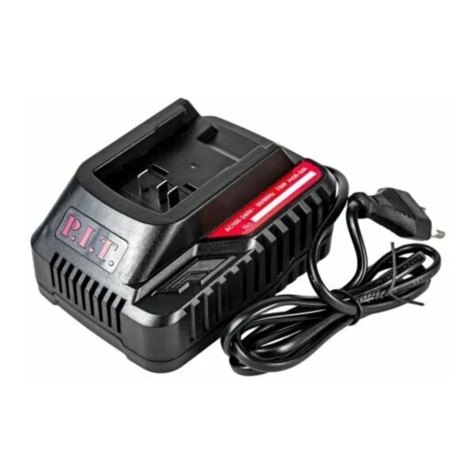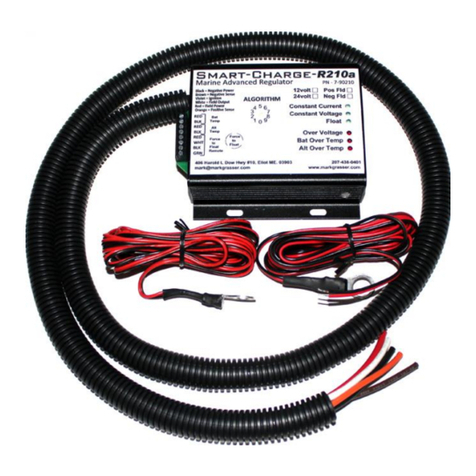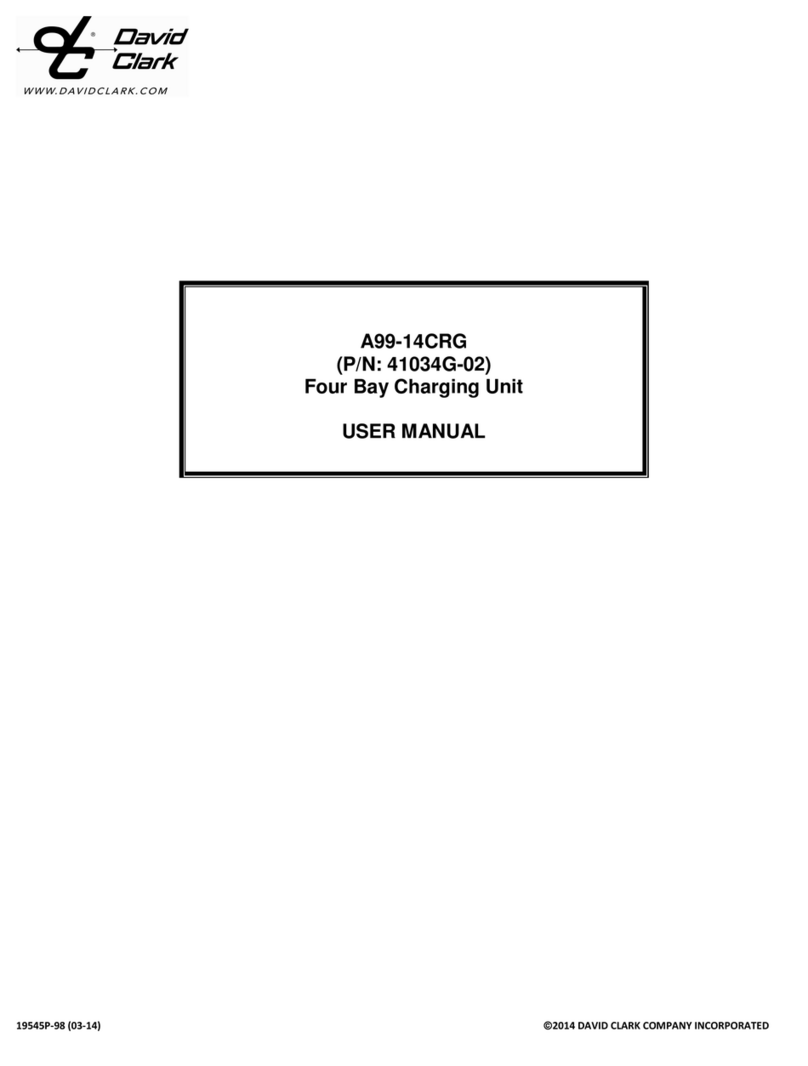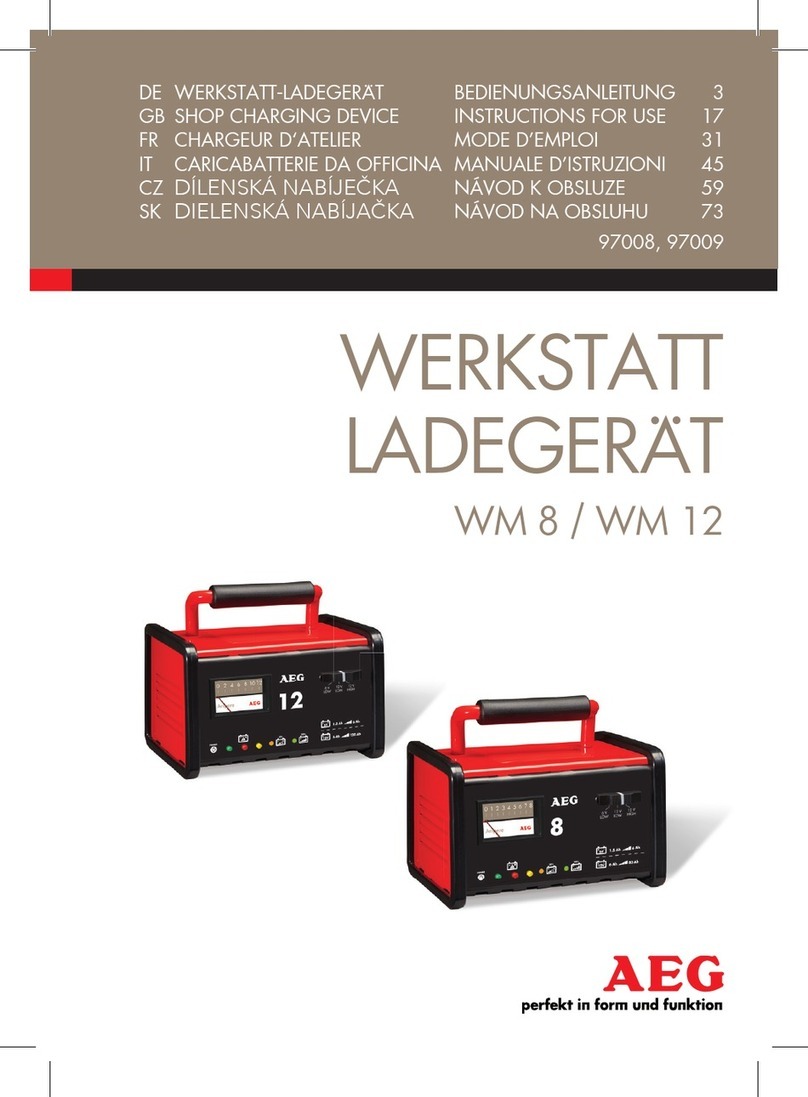Siegen tools S0547 User manual

DANGER! BE AWARE, LEAD-ACID BATTERIES GENERATE EXPLOSIVE GASES
DURING NORMAL BATTERY OPERATION. FOR THIS REASON, IT IS VERY
IMPORTANT TO READ AND FOLLOW THESE INSTRUCTIONS CAREFULLY, EACH TIME YOU
USE THE CHARGING EQUIPMENT.
Follow these instructions and those published by the battery and vehicle manufacturers,
and the maker of any equipment you intend to use in the vicinity of the battery.
Remember to review warning marks on all products and on engines.
BEFORE USING THIS PRODUCT PLEASE READ THESE INSTRUCTIONS PAYING PARTICULAR ATTENTION TO SAFETY ADVICE
AND WARNINGS. ONLY USE THIS PRODUCT AS INTENDED - DAMAGE/INJURY MAY RESULT FROM INCORRECT USE OR
FAILURE TO COMPLY WITH THE INSTRUCTIONS AND AND OR WILL INVALIDATE THE WARRANTY.
INSTRUCTION MANUAL
BATTERY
CHARGERS 230V
MODEL NUMBERS
S0547
S0548
S0547, S0548 (2) 24/11/08
1.1. ELECTRICAL SAFETY
WARNING! It is the user’s responsibility to read, understand and
comply with the following:
You must check all electrical equipment and appliances to ensure they are safe
before using. You must inspect power supply leads, plugs and all electrical
connections for wear or damage. You must ensure the risk of electric shock is
minimised by the installation of appropriate safety devices. An RCCB (Residual
Current Circuit Breaker) should be incorporated in the main distribution board.
We also recommend that an RCD (Residual Current Device) is used with all
electrical products.
It is particularly important to use an RCD with portable products that are plugged
into an electrical supply not protected by an RCCB.
If in doubt consult a qualified electrician. You may obtain a Residual Current Device
by contacting your dealer. You must also read and understand the following
instructions concerning electrical safety.
1.1.1. The Electricity At Work Act 1989 requires all portable electrical
appliances, if used on business premises, to be tested by a qualified
electrician, at least once a year, using a Portable Appliance Tester (PAT).
1.1.2. The Health & Safety at Work Act 1974 makes owners of electrical
appliances responsible for the safe condition of those appliances and the
safety of appliance operators.
If in any doubt about electrical safety, contact a qualified electrician.
1.1.3. Ensure the insulation on all cables and the product itself is safe before
connecting to the mains power supply.
See 1.1.1. & 1.1.2. above and use a Portable Appliance Tester (PAT).
1.1.4. Ensure that cables are always protected against short circuit and overload.
1.1.5. Regularly inspect power supply, leads and plugs for wear or damage and
also power connections to ensure that none is loose.
1.1.6. Important: Ensure the voltage marked on the product is the same as the
electrical power supply to be used and check that plugs are fitted with the
correct capacity fuse. A 13 amp plug may require a fuse smaller than 13
amps for certain products - see fuse rating below.
1.1.7. DO NOT pull or carry appliance by power supply lead or output leads.
1.1.8. DO NOT pull power plugs from sockets by the power cable.
1.1.9. DO NOT use worn or damage leads, plugs or connections. Immediately
replace or have repaired by a qualified electrician. Where a U.K. 3 pin plug
with ASTA/BS approval is fitted, in case of damage, cut off and fit a new
plug according to the following instructions (discard old plug safely).
(UK only - see diagram below). Ensure the unit is correctly earthed via
a three-pin plug.
a) Connect the GREEN/YELLOW earth wire to the earth terminal ‘E’.
b) Connect the BROWN live wire to the live terminal ‘L’.
c) Connect the BLUE neutral wire to the neutral terminal ‘N’.
d) After wiring, check that there are no bare wires, that all wires have been
correctly connected, that the cable external insulation extends beyond the
cable restraint and that the restraint is tight.
Double insulated products are fitted with live (BROWN) and neutral (BLUE) wires
only. Double insulated products are always marked with this symbol .
To re-wire, connect the brown & blue wires as indicated above. DO NOT
connect the brown or blue wires to
the earth terminal.
1.1.10. NOTE: If this product
requires more than a 13
amp electrical supply, then
NO plug is fitted. You must
therefore contact a
qualified electrician to
ensure that a 30 amp fused
supply is available.
We recommend you
discuss the installation of a
industrial round pin plug
and socket with your
electrician.
1.1.11. Cable extension reels.
When a cable extension
reel is used it should be
fully unwound before
connection. A cable reel with an RCD fitted is recommended since any
product which is plugged into the cable reel will be protected. The section
of the cores in the cable is important and should be at least 1.5mm2, but
to be absolutely sure that the capacity of the cable reel is suitable for this
product and for others that may be used in the other output sockets, we
recommend the use of 2.5mm2 section.
1.2. PERSONAL PRECAUTIONS
Ensure there is another person within hearing range of your
voice and close enough to come to your aid, should a
problem arise when working near a lead-acid battery.
Wear safety eye protection and protective clothing. Avoid touching eyes while
working near battery.
Have fresh water and soap nearby in case battery acid contacts skin, clothing,
or eyes.
Wash immediately with soap and water if battery acid contacts skin or clothing.
If acid enters eye, flush eye immediately with cool, clean running water for at
least 15 minutes and seek immediate medical attention.
Remove personal metallic items such as rings, bracelets, necklaces and
watches. A lead-acid battery can produce a short-circuit current which is high
enough to weld a ring or the like to metal, which would cause severe burns.
Ensure hands, clothing (especially belts) are clear of fan blades and other
moving or hot parts of engine, remove ties and contain long hair.
DO NOT smoke or allow a spark or flame in the vicinity of battery or engine.
1.3. GENERAL SAFETY INSTRUCTIONS
Familiarise yourself with the application and limitations of the charger as well as
the potential hazards. Also refer to the vehicle manufacturer’s handbook.
If in any doubt consult a qualified service agent.
Ensure the charger is in good order and condition before use. If in any doubt do
not use the unit and contact a qualified service agent.
Only use recommended attachments and parts. To use unapproved items may
be dangerous and will invalidate your warranty.
Use the charger in the upright position only and ensure it is placed on a stable
surface which will adequately support its weight.
Ensure the charger is disconnected from the mains supply before attaching or
detaching the power clamps to/from the battery.
Keep tools and other items away from the engine and ensure you can see the
battery and working parts of engine clearly.
Ensure the output voltage of the charger is the same voltage as the battery.
If battery has caps to access the battery fluid, remove the caps and check the
fluid level before connecting the power clamps. If necessary top-up the battery
with distilled water by referring to the battery manufacturer’s instructions. Apply
the personal safety precautions described in part 1.2.
If the charger receives a sharp knock or blow the unit must be checked by a
qualified service agent before using.
If the battery terminals are corroded or dirty clean them before attaching the
power clamps.
Keep children and unauthorised persons away from the working area.
DO NOT disassemble the charger for any reason. The charger must only be
checked by qualified service personnel.
DO NOT try to charge a non-rechargeable battery.
DO NOT try to start engine when charger is connected to battery.
DO NOT try to charge battery if fluid is frozen.
WARNING! To prevent the risk of sparking, short circuit and possible explosion
DO NOT drop metal tools in the battery area, or allow them to touch the battery
terminals.
DO NOT allow power clamps to touch each other or to make contact with any
metallic part of the vehicle.
DO NOT cross-connect power leads from charger to battery. Ensure positive (+/
RED) is to positive and negative (-/BLACK) is to negative.
DO NOT pull the cables or clamps from the battery terminals.
DO NOT use the charger outdoors, or in damp, or wet locations and DO NOT
operate within the vicinity of flammable liquids or gases.
DO NOT use charger inside vehicle or inside engine compartment.
Ensure there is effective ventilation to prevent a build-up of explosive gases,
and do not cover or obstruct charger ventilation louvres.
DO NOT use the charger for a task for which it is not designed.
WARNING! DO NOT simultaneously charge batteries of different capacities or
discharge levels.
WARNING! If a fuse blows, ensure it is replaced with an identical fuse type and
rating. Use only Sealey genuine parts.
When not in use, store the charger carefully in a safe, dry, childproof location.
Blue
Neutral
Wire
Yellow & Green
Earth Wire
Cable
Restraint
FUSE RATING
THE PLUG FITTED TO THIS
PRODUCT MUST BE EQUIPPED
WITH A
3AMP FUSE
Brown
Live
Wire
E-mail: [email protected]
Sole UK Distributor, The Siegen Tool Co, Bury St. Edmunds, Suffolk.

2 SPECIFICATIONS
Model No. S0547 S0548
Output 12V Peak (EN). .......4A(2.6A) ............6A(3.1A)
Input......................230V 0.3A .......... 230V 0.3A
Fuse Rating. ..................10A................10A
Fuse Reference ........... 120/802255..........120/802255
Robust battery chargers suitable for home and light workshop use. Each
features LEDs to indicate the level of battery charge. Composite
housing with in-built carry handle. External fuse protection for simple
replacement. 1.3mtr cable complete with insulated clamps. Supplied with
BS approved non-rewireable plug.
3 OPERATION
WARNING! This charger is suitable only for lead Acid Batteries
and should not be used to re-charge Ni-Cd or any other type of
battery.
DO NOT charge batteries smaller than 20Ah or greater than 120Ah.
WARNING! Ensure you read, understand and apply the safety
and operational instructions before connecting the charger
power clamps to the battery. Only when you are sure that you
understand the procedures is it safe to proceed with the actual
charging process.
3.1 BATTERY PREPARATION
Caution ! Ensure you wear appropriate personal protection
including safety goggles as some electrolyte spillage may occur
during the following procedure
It is advised before charging, to disconnect and remove the battery from
the vehicle to prevent damage to sensitive on-board equipment.
Caution ! Before removing or replacing your battery ensure you
read the vehicle handbook and carefully follow the instructions
relating to battery removal and fitting.
3.1.1 If the battery is not a sealed unit, remove the filler caps and
check the level of the electrolyte. If it is below the recommended
level, top up using distilled water.
Do not use tap water under any circumstances.
3.1.2 To prevent acid splashing during the charging process, replace
the filler caps but do not tighten them, allowing gases to escape.
3.1.3 If sealed unit, it is unnecessary to carry out these checks.
3.2 CONNECTION
3.2.1 To avoid sparks which could cause an explosion, ensure the
charger is disconnected from the mains supply before making or
breaking connections.
3.2.2 Connect the crocodile clips to the battery in the following order:
a) Connect positive charging lead (RED) to the positive post of
the battery (marked P or +).
b) Connect the negative lead (BLACK) to the negative post of
the battery (market N or -). It is important that the crocodile clips
make good contact with the battery terminals. If necessary use
a small wire brush to clean the terminals.
3.2.3 The battery is fitted with an external, reverse polarity protection
10A fuse. If the leads are incorrectly connected the fuse will
blow. If this situation should occur, disconnect the charger from
the mains and replace the fuse located on the right hand side of
the charger with
another of the same value, part ref: 120/802255.
DO NOT fit a fuse of any other value.
4 FAULTS
WARNING! DO NOT use the charger if damaged or
thought to be faulty (Contact Service Agent).
• Panellights
fail to light.
• Panellights
flicker and go
out.
•
Switch OFF
immediately at
the mains.
• Ensuretheoutputleadsarenot
touching.
• Ensurethepolarityiscorrect,RED
lead to + battery terminal, BLACK
lead to - negative terminal and check
external fuse. When satisfied all is
correct switch on the mains and
check again.
Fault
Fault
Action
Action
Remedy
Remedy
• SwitchOFF
immediately
at
the mains.
• Ensuretheoutputleadsarenot
damaged.
• Ensurethecrocodileclipsare
making good contact with the
battery posts, switch on the mains
and check again.
NOTE: It is our policy to continually improve products and as such we reserve the right to alter data, specifications and component parts without prior notice.
IMPORTANT: No liability is accepted for incorrect use of this equipment. WARRANTY: Guarantee 12 months from purchase date, proof of which will be required for any claim.
Declaration of Conformity We, the sole UK importer, declare that these products listed below are in conformity with the following standards and directives.
The construction files for these products
are held by the Manufacturer and
may be inspected, by a national authority,
upon request to The Siegen Tool Co.
Electronic Battery Chargers 230V
Models: S0547, S0548
2004/108/EC EMC Di r E C t i v E
2006/95/EC Lo w vo L t a g E Di r E C t i v E
93/68/EEC CE Ma r k i n g Di r E C t i v E
Signed by Mark Sweetman
24th November 2008
E-mail: [email protected]
Sole UK Distributor, The Siegen Tool Co., Bury St. Edmunds, Suffolk
When not in use, disconnect from the mains supply and
store the charger carefully in a safe, dry, childproof location.
3.3 CHARGER SETTINGS (S0548 ONLY)
This charger is fitted with two charging options:
1 Float charge: This setting monitors the condition of the battery
and will automatically start or stop the charging cycle to maintain
a charged battery.
NOTE: Using the float setting, the battery may be left permanently
connected to the charger.
2 Full Charge: Continuously charges the battery. The charger
continues to give a small output even when battery is charged.
NOTE:
This setting may be used to top-up a battery that has been on float
charge.
WARNING! The battery should not be left for long periods when
using the Full Charge option.
3.4 CHARGING
3.4.1 Plug the charger into the mains supply (230V AC only) and on
S0548 only select the float or full charge option.
3.4.2 Switch on supply to commence the charging procedure.
3.4.3 The rate of charge will now be displayed by the LEDs on the
front of the charger.
The smaller the number of LEDs illuminated the higher the
current flowing into the battery. As the battery charges, less
current will be drawn and more LEDs will be lit. When the battery
is fully charged all LEDs will be lit.
When a flat battery is initially connected to the charger, the charging rate
should build up quickly. As the battery becomes more charged the rate of
charge will drop, this is normal.
WARNING! Do not attempt to start the vehicle whilst connected to
the charger as this will damage the unit.
3.4.4 Regularly check the specific gravity of the electrolyte using a
hydrometer, until a reading of fully charged is reached. A charging time of
no more than 10hrs is advised for batteries of 34 to 45 Ah capacity.
3.4.5 When charging is complete, switch off the mains supply. Unplug
the charger and disconnect the leads from the battery. Inspect the
electrolyte levels in each of the battery cells and top up if necessary
using distilled water. Replace the filler caps ensuring they are fully
tightened or pushed home. Any surplus fluid on the surface of the battery
should be wiped off (this should be done with extreme care as it may be
acidic).
This manual suits for next models
1
Other Siegen tools Batteries Charger manuals
Popular Batteries Charger manuals by other brands

TRACTION
TRACTION MPL50-Li operating instructions
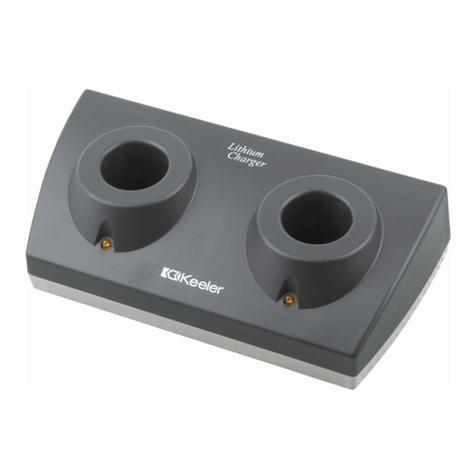
Keeler
Keeler 1941-P-1368 manual

Bosch
Bosch BAT 415 operating instructions
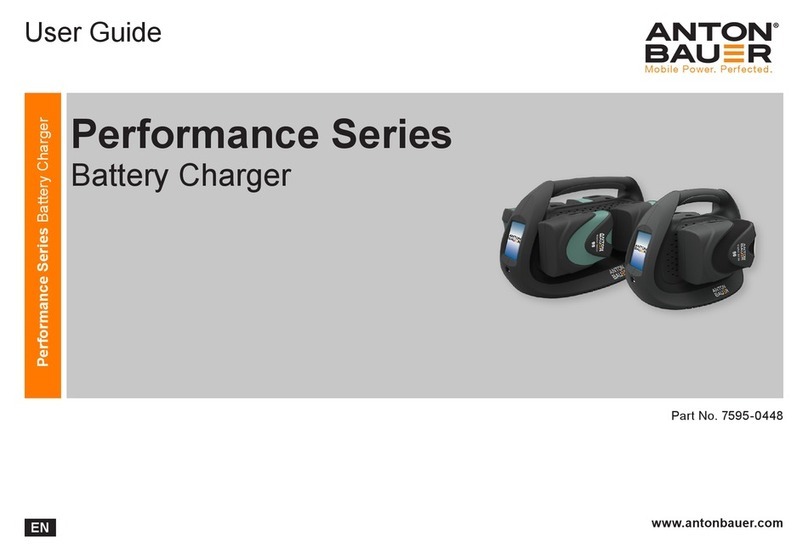
Anton/Bauer
Anton/Bauer Interactive 2000 PowerCharger user guide

Green Digital Power-tech
Green Digital Power-tech A500CM-XX user manual
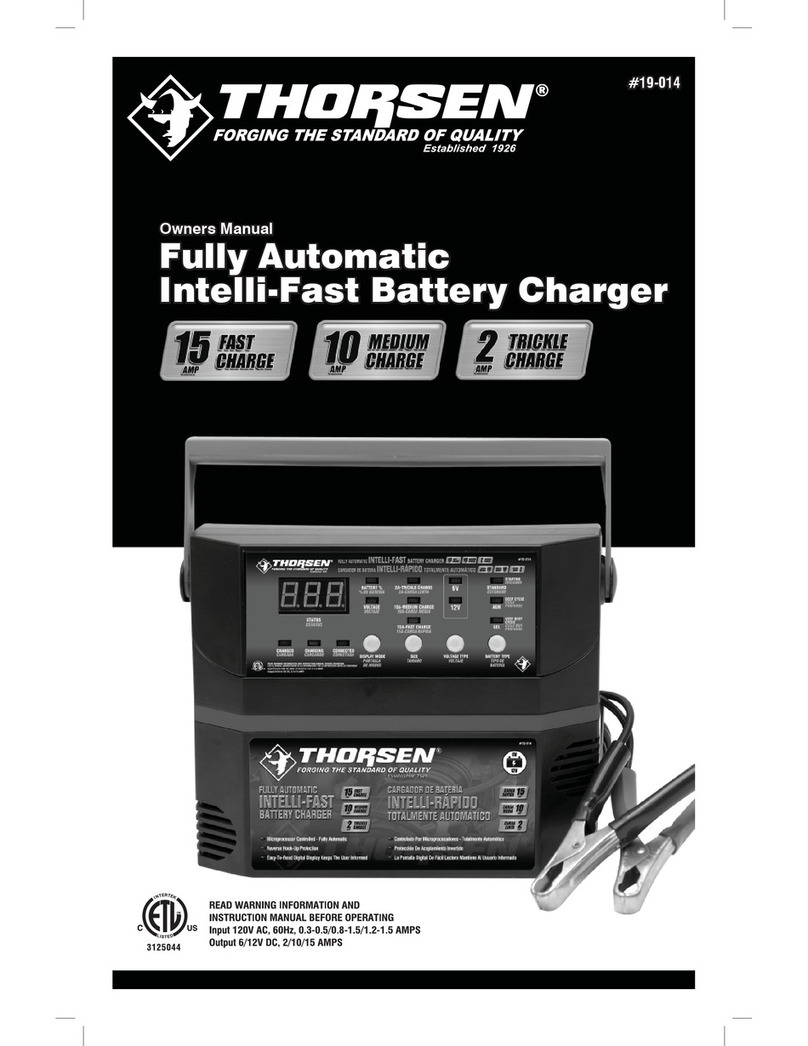
Thorsen
Thorsen Fully Automatic Intelli-Fast Battery Charger owner's manual
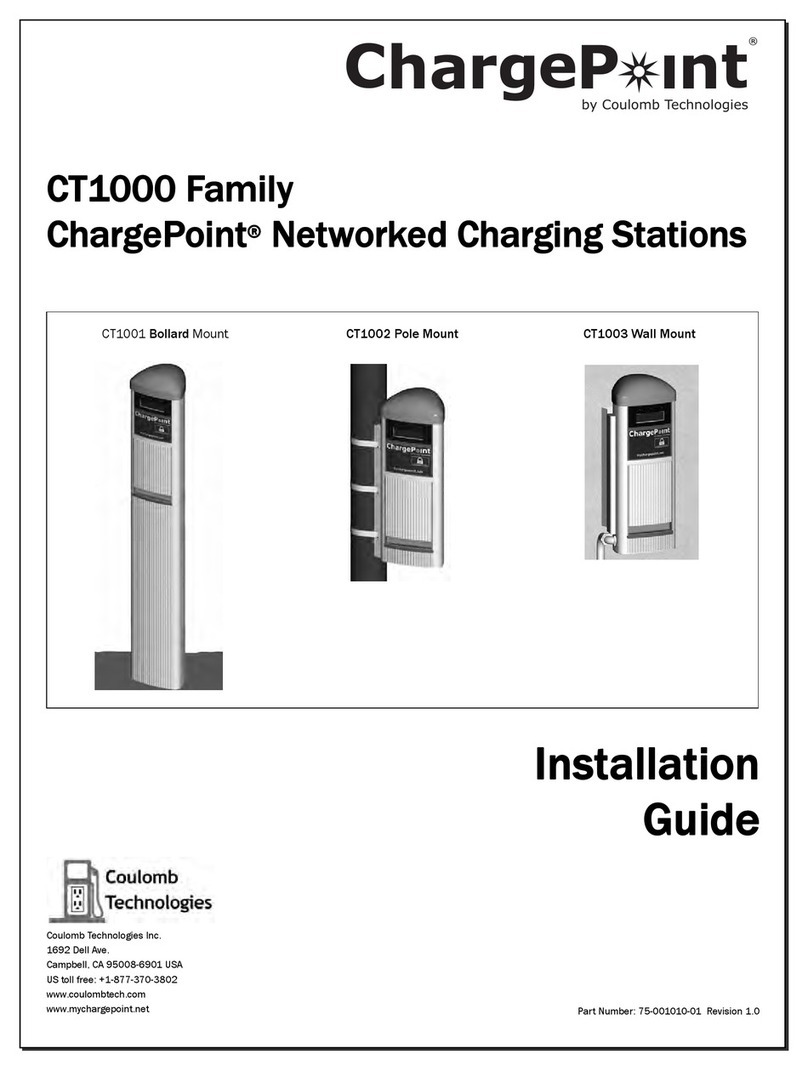
ChargePoint
ChargePoint CT1000 series installation guide

Lester
Lester 24EL8 Service instructions

Hubbell
Hubbell EVSE installation instructions
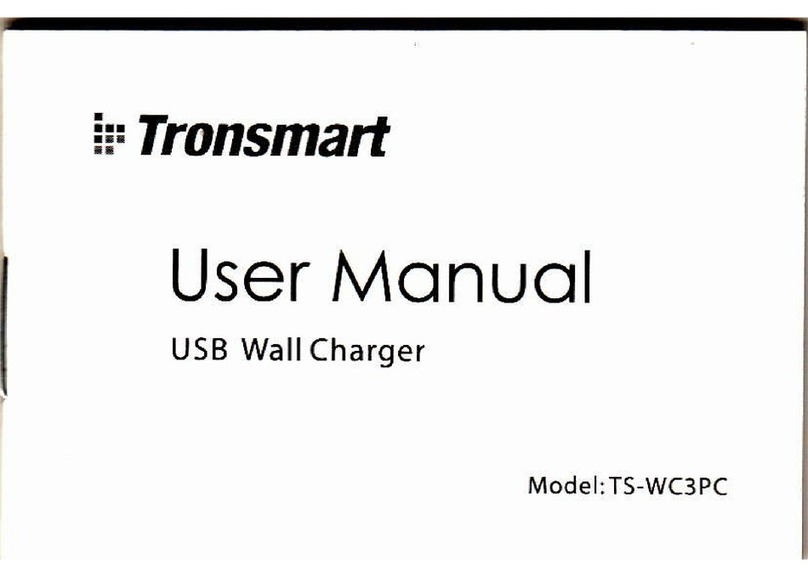
Tronsmart
Tronsmart TS-WC3PC user manual
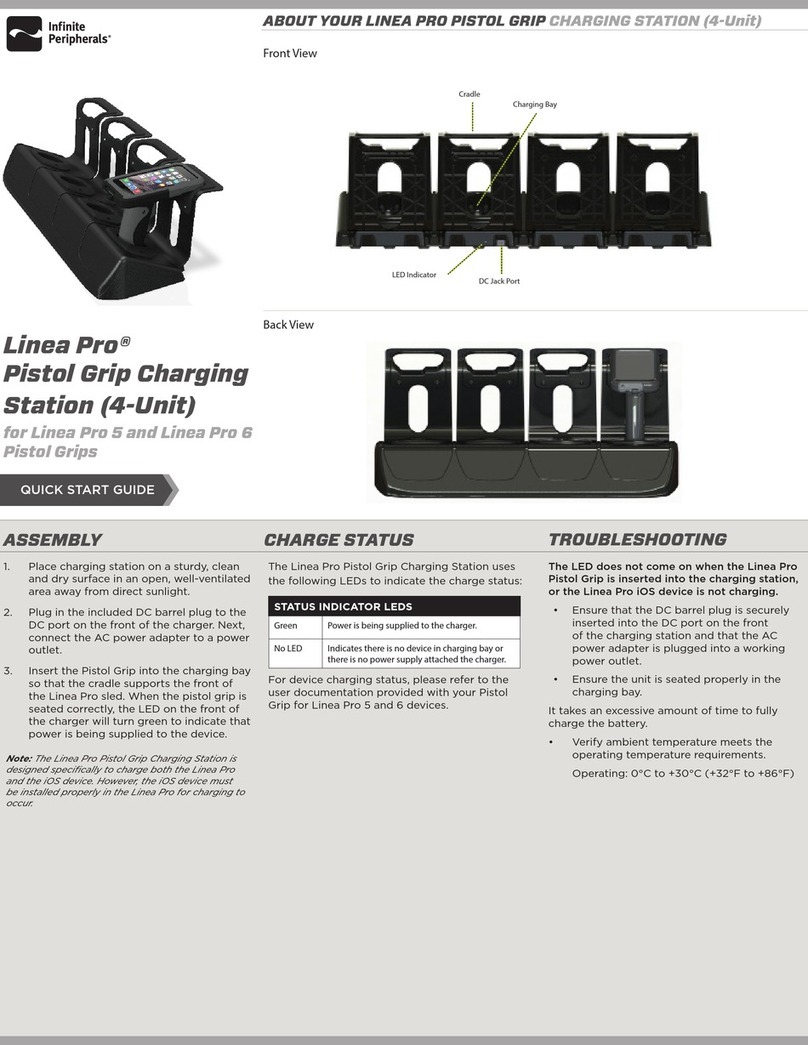
Infinite Peripherals
Infinite Peripherals Linea Pro Pistol Grip Charging Station quick start guide
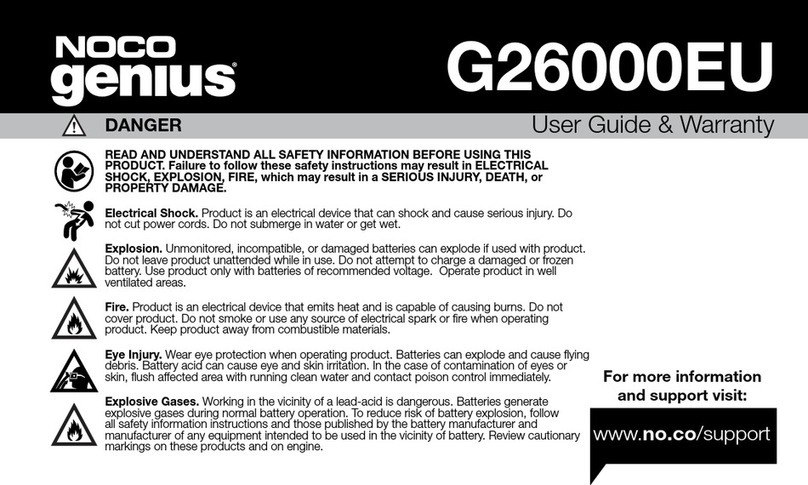
NOCO Genius
NOCO Genius G26000EU User guide & warranty

